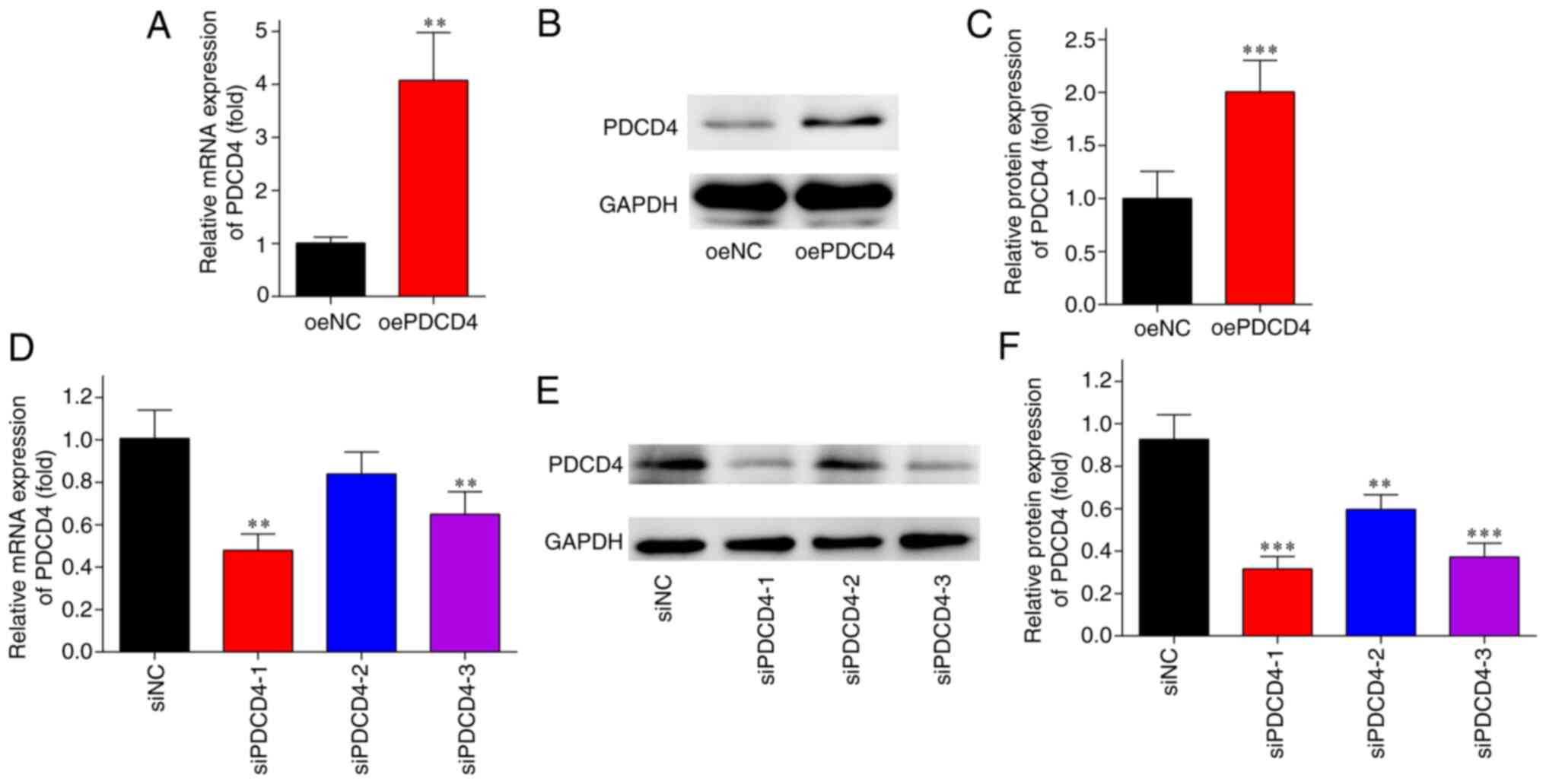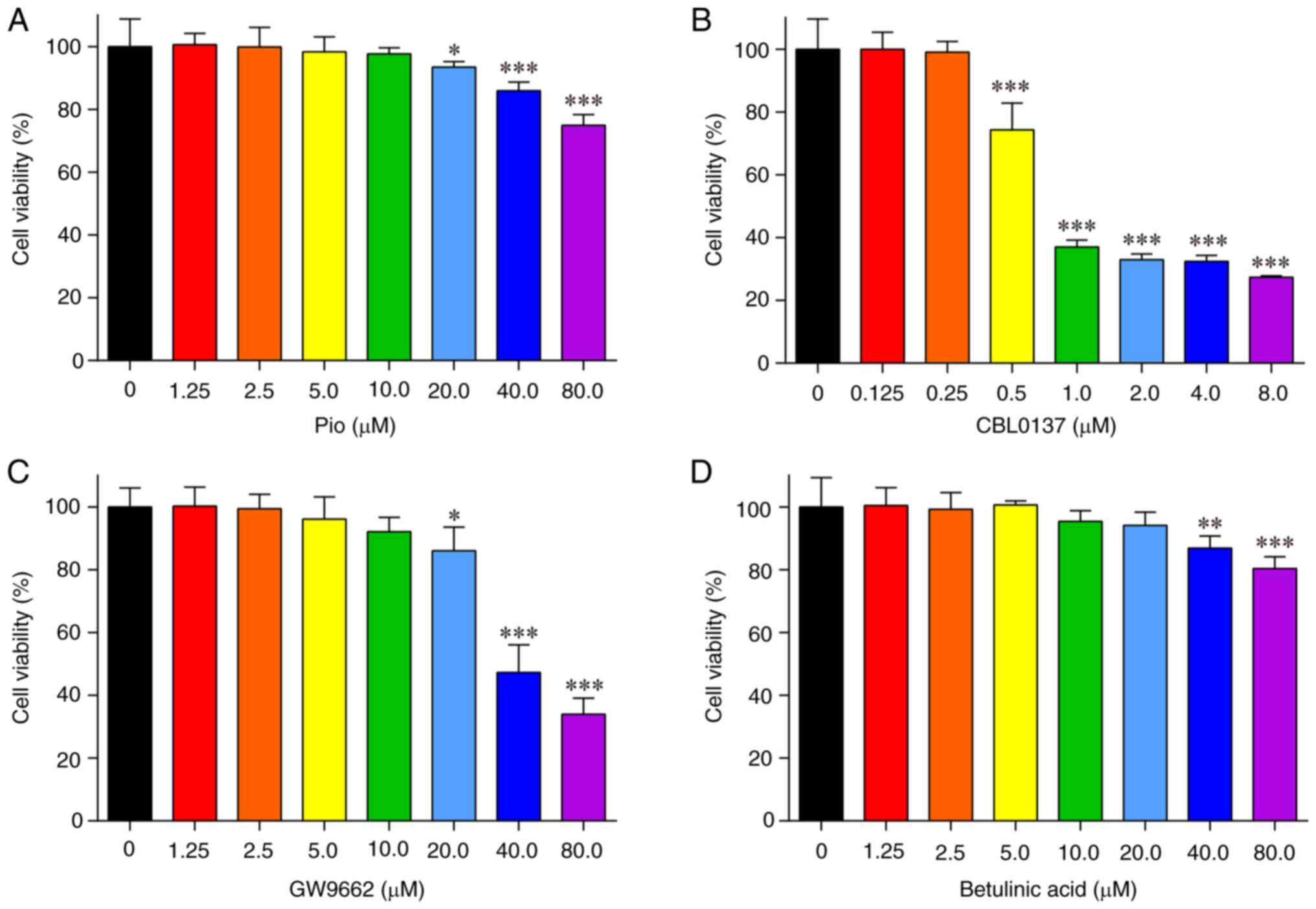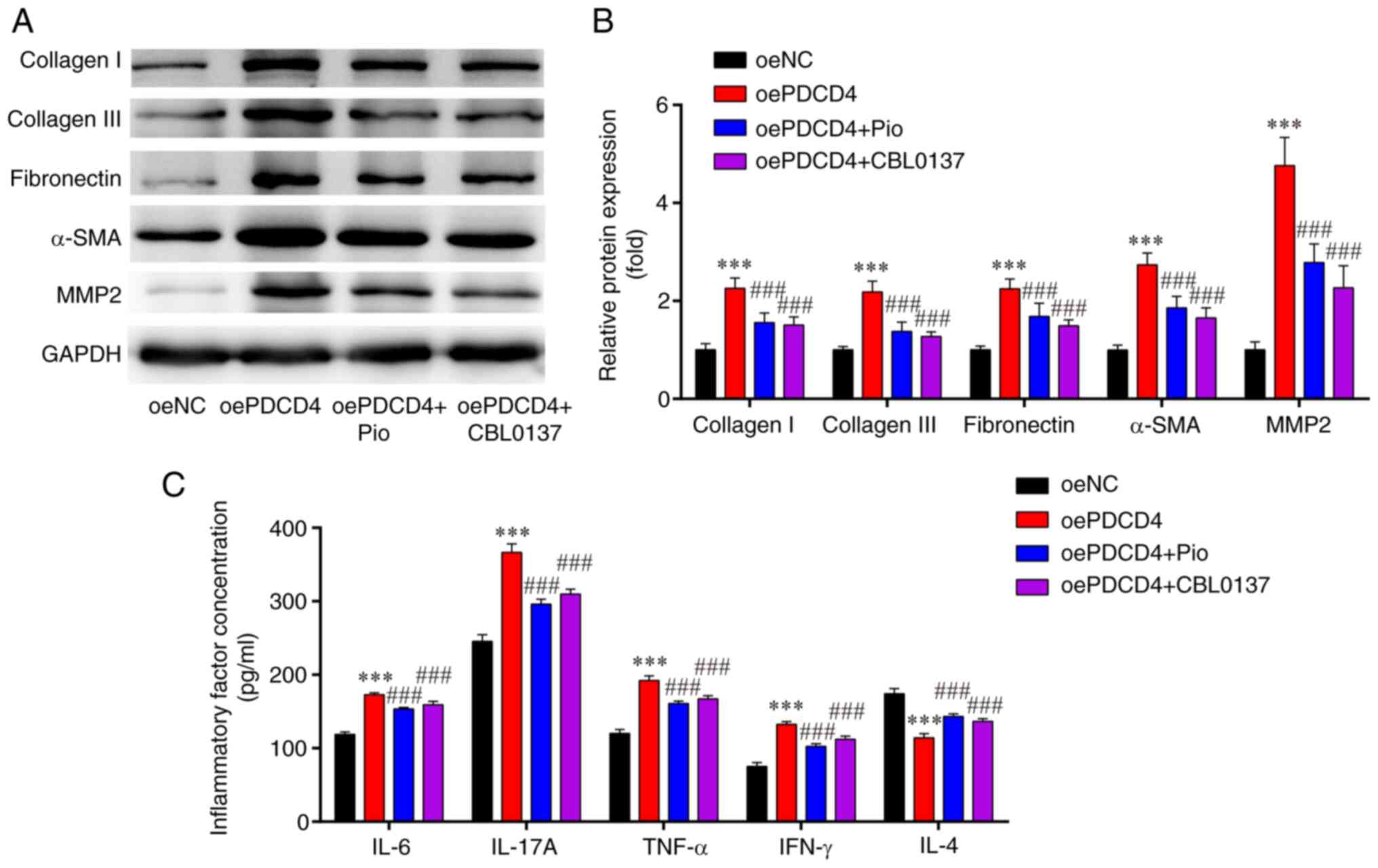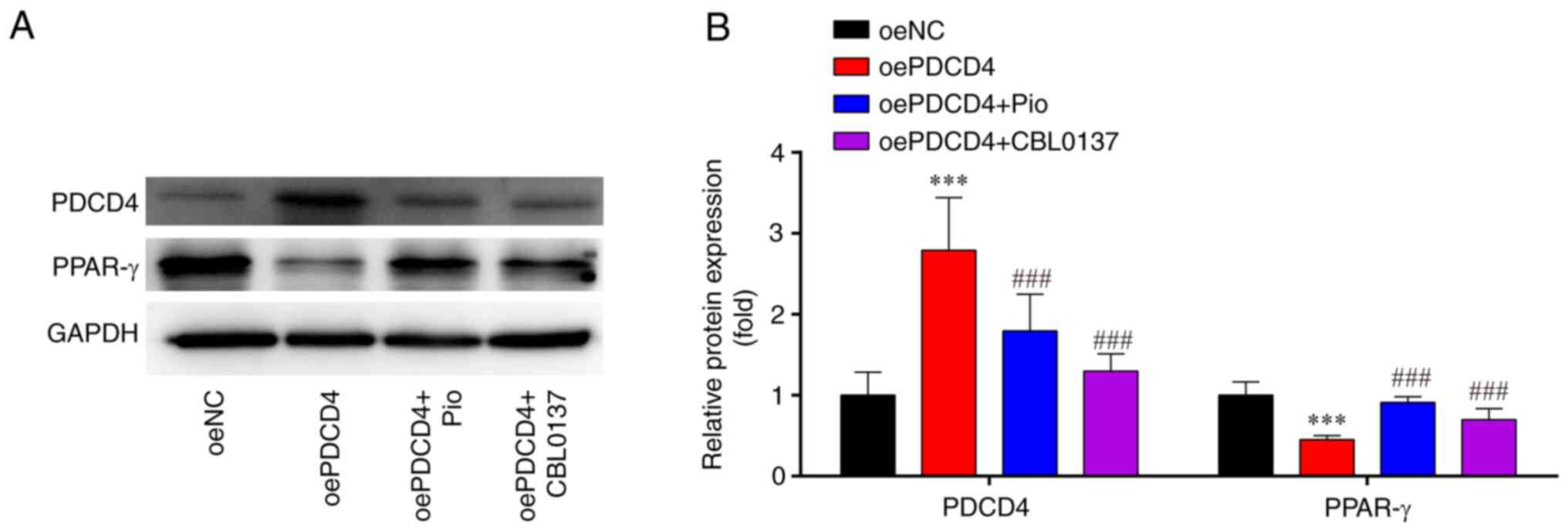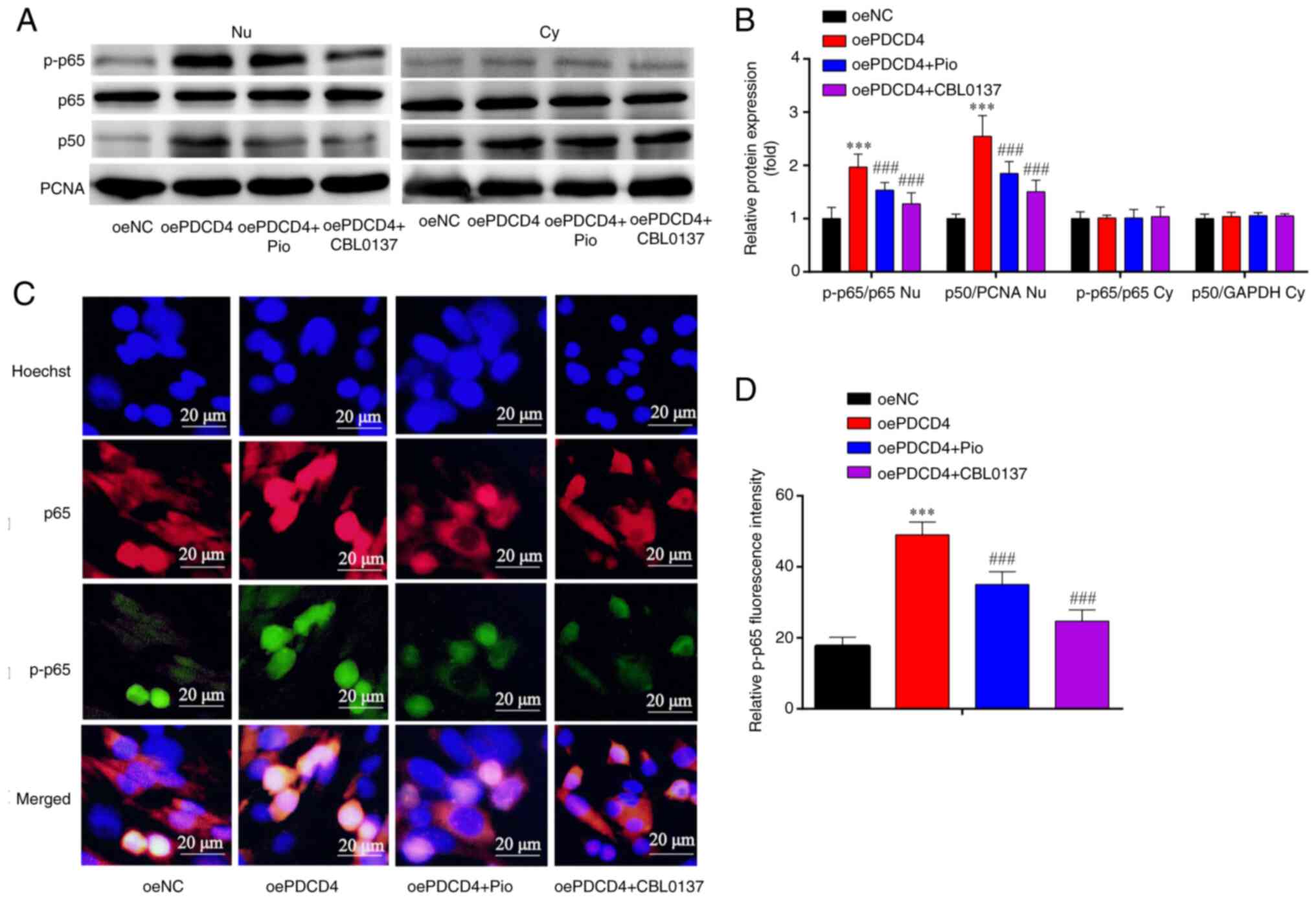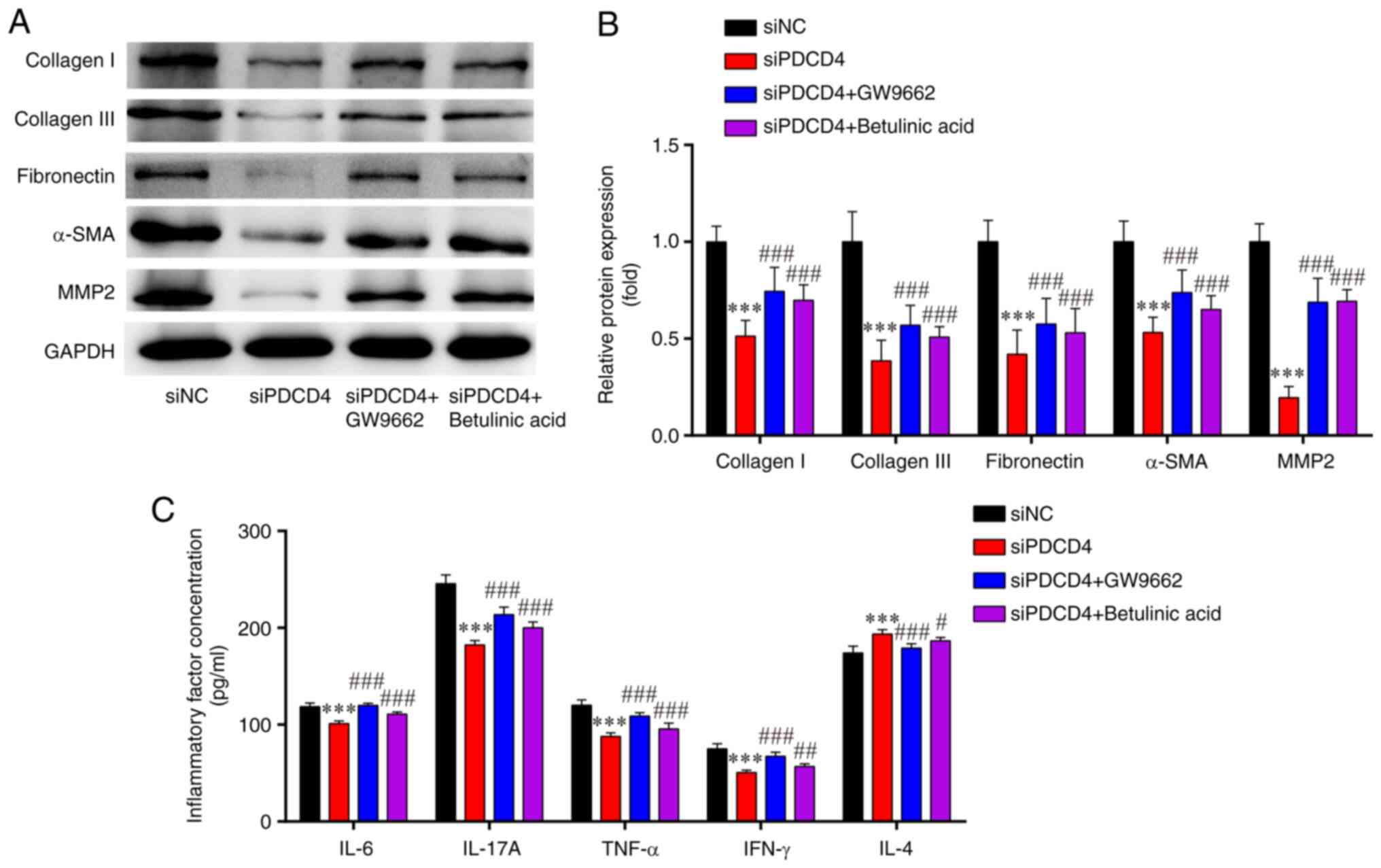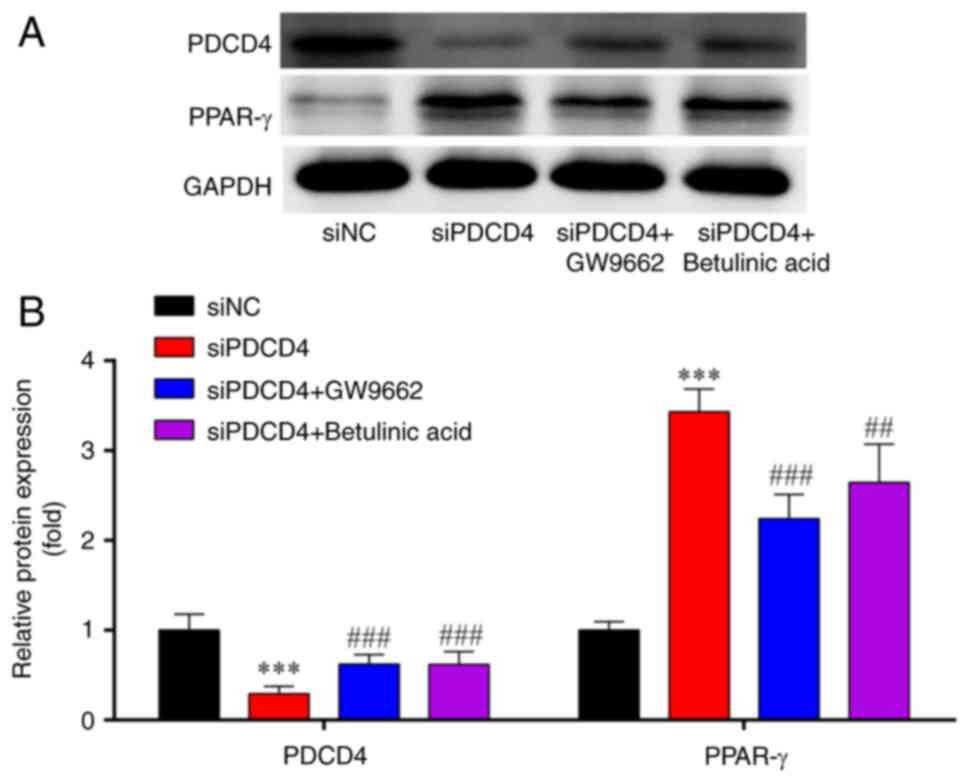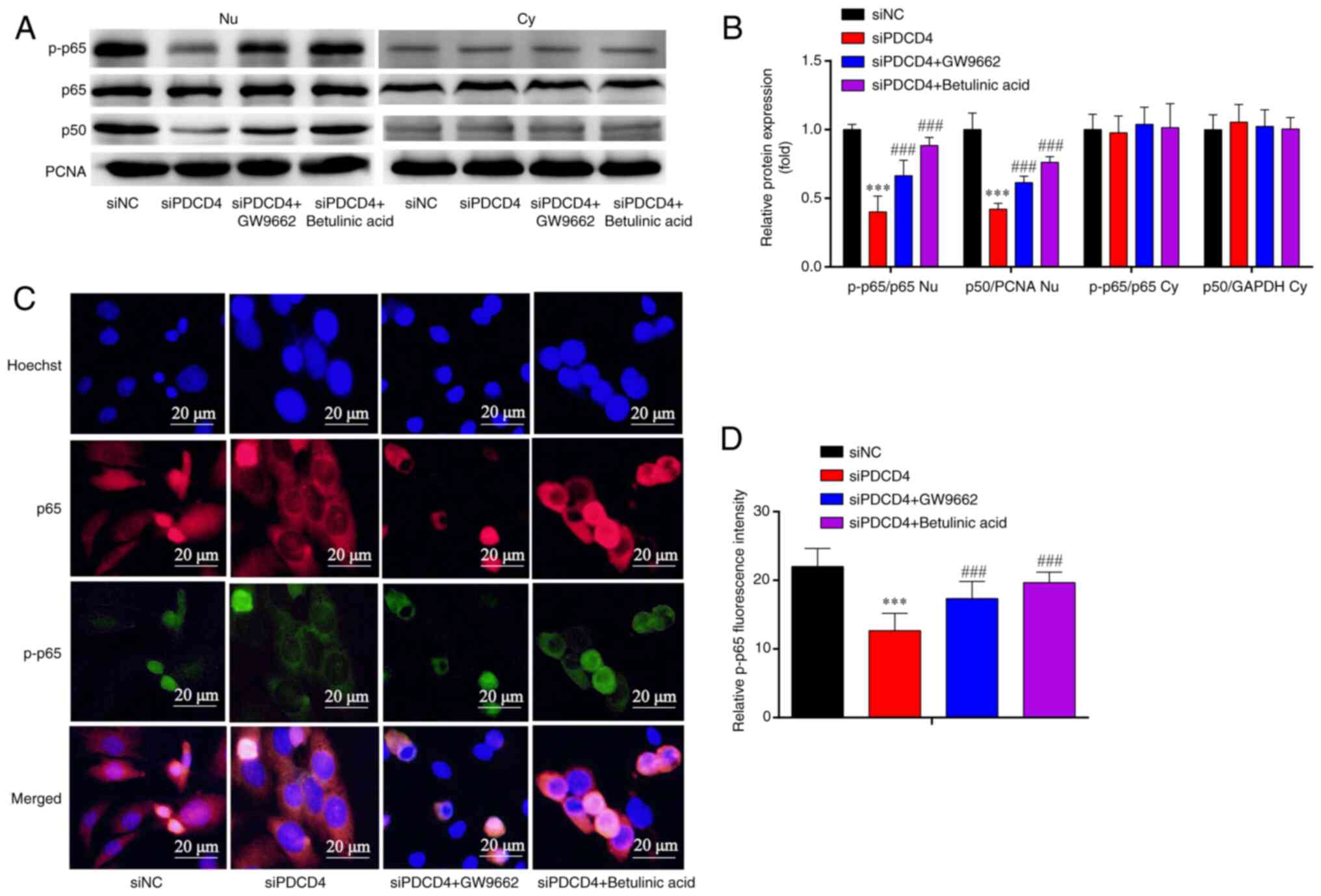PDCD4 promotes inflammation/fibrosis by activating the PPAR‑γ/NF‑κB pathway in mouse atrial myocytes
- Authors:
- Published online on: September 19, 2024 https://doi.org/10.3892/mmr.2024.13333
- Article Number: 209
-
Copyright: © Yu et al. This is an open access article distributed under the terms of Creative Commons Attribution License.
Abstract
Introduction
Atrial fibrillation (AF), which affects >37.5 million individuals worldwide, is the most common and persistent type of arrhythmia and AF is also the second most common cause of mortality (1,2). The main mechanism involved in AF is structural remodeling (3). AF places a burden on families and society; however, its pathogenesis remains unclear.
Previous studies have identified an association between inflammation and the occurrence/maintenance of AF (2,4). Inflammation is a protective biological response of a host to infection-induced damage; when such changes occur in the atrium, inflammation induces atrial fibrosis, which predisposes individuals to AF. Notably, fibrosis is considered the basis for the structural remodeling of the atrium (5). In addition, AF induces atrial inflammation, which activates cardiac fibroblasts to cause atrial fibrotic remodeling, thus generating a vicious cycle; that is, AF-inflammation-fibrosis (5). Fibrosis and inflammation directly or indirectly promote the structural remodeling of AF (5–7). In addition, inflammation and fibrosis not only function in the occurrence and development of AF, but also serve etiological roles in its pathogenesis.
The amino-terminal sequence which is encoded by programmed cell death factor 4 (PDCD4) is highly conserved among species and freely shuttles within and out of the nucleus. Notably, PDCD4 is enriched in the inflammatory process of AF and is associated with a high risk of developing stroke in patients with AF (8). PDCD4 regulates the pathophysiological processes of fibrosis and inflammation (9,10); the silencing or knockdown of PDCD4 has been shown to reduce inflammation in human dermal papillary cells (11), and to improve ventricular remodeling, oral mucosal fibrosis and liver fibrosis (12–14). However, the mechanisms by which PDCD4 affects AF, inflammation and fibrosis remain to be elucidated.
As a transcription factor in the nuclear receptor superfamily, peroxisome proliferator-activated receptor γ (PPARγ) is deemed to be a prospective target for treating inflammatory diseases (15). The PPARγ agonist pioglitazone hydrochloride (Pio) can reduce TNF-α expression, thereby attenuating the inflammation of bronchial occlusion following lung transplantation (16). NF-κB is an inflammatory transcription factor, the activation of which is caused by a variety of external stimuli, such as inflammation and immune responses (17). During inflammation, the activation of PPARγ inactivates NF-κB by direct binding to NF-κB p65, resulting in a diminished inflammatory response after ubiquitin degradation (18).
The present study aimed to determine whether PDCD4 mediates PPARγ-mediated inflammation via the NF-κB pathway, inducing the structural remodeling of mouse atrial myocytes (HL-1 cells).
Materials and methods
Cells, cell culture, transfection and treatment
Mouse atrial myocytes (HL-1; cat. no. iCell-m077; iCell Bioscience, Inc.) were grown in minimum essential medium containing 1% streptomycin/penicillin plus 10% fetal calf serum (Thermo Fisher Scientific, Inc.) in an incubator at 37°C and 5% CO2.
Overexpression negative control plasmid pcDNA3.1 (oeNC; 2 µg; GenScript), PDCD overexpression plasmid (oePDCD4; 2 µg; GenScript), or small interfering (si)RNA NC (siNC; 10 nM; Guangzhou RiboBio Co., Ltd.) and PDCD4 siRNAs (siPDCD4-1, 2 and 3; 10 nM; Guangzhou RiboBio Co., Ltd.) were transfected into HL-1 cells (3×105 cells/well) using Lipofectamine® 2000 (Thermo Fisher Scientific, Inc.) for 48 h at 37°C. At 48 h after transfection, cells were harvested for the subsequent experiments. The sequences of siNC, siPDCD4-1, siPDCD4-2 and siPDCD4-3 are provided in Table I.
The HL-1 cells in the overexpression group were further divided into four groups as follows: i) oeNC; ii) oePDCD4; iii) oePDCD4 + PPARγ agonist (Pio; 0, 1.25, 2.5, 5, 10, 20, 40 and 80 µM, cat. no. HY-14601; MedChemExpress); and iv) oePDCD4 + NF-κB inhibitor (CBL0137; 0, 0.125, 0.25, 0.5, 1, 2, 4 and 8 µM, cat. no. HY-18935A; MedChemExpress). The HL-1 cells in the silencing group were further divided into the following four groups: i) siNC; ii) siPDCD4; iii) siPDCD4 + PPARγ inhibitor (GW9962; 0, 1.25, 2.5, 5, 10, 20, 40 and 80 µM, cat. no. M6191-5MG; Merck KGaA); and iv) siPDCD4 + NF-κB agonist (betulinic acid; 0, 1.25, 2.5, 5, 10, 20, 40 and 80 µM, cat. no. HY-10529; MedChemExpress). The medium was changed every day. The cells were harvested following 48 h of transfection and 24 h of drug treatment at 37°C.
Reverse transcription-quantitative PCR (RT-qPCR)
Total RNA was extracted from the HL-1 cells using TRIzol® reagent (Thermo Fisher Scientific, Inc.) and cDNA was generated using a RevertAid First Strand CDNA Synthesis Kit (Thermo Fisher Scientific, Inc.) according to manufacturer's protocol. Subsequently, cDNA (2 µl) was used for qPCR (20 µl reaction volume), which was performed using 2X SYBR-Green qPCR MasterMix (Thermo Fisher Scientific, Inc.) on A 7500HT Fast real-time PCR System (Applied Biosystems; Thermo Fisher Scientific, Inc.). The cycling conditions were as follows: initial denaturation at 94°C for 10 min, 94°C for 20 sec, 55°C for 20 sec and 72°C for 20 sec, for a total of 40 cycles, followed by a final extension at 72°C. The mRNA expression levels of PDCD4 were normalized to GAPDH using the 2−ΔΔCq method (19). GAPDH served as an internal control. The sequences of the primers used are given in Table II.
Western blot analysis
Nuclear (Nu) and cytoplasmic (Cy) proteins from HL-1 cardiomyocytes were isolated using NE-PER™ (Thermo Fisher Scientific, Inc.). Total proteins were extracted from the HL-1 cardiomyocytes utilizing RIPA lysis buffer (Beijing Solarbio Science & Technology Co., Ltd.) containing PMSF and protease inhibitor mixture (Roche Diagnostics). The protein concentration was assessed using a BCA protein concentration assay kit (Biosharp Life Sciences). The proteins (15 µg/lane) were then separated by sodium dodecyl-sulfate polyacrylamide gel electrophoresis on 10% gels and were transferred onto polyvinylidene fluoride (PVDF) membranes (MilliporeSigma). Then the PVDF membranes were blocked by 5% non-fat milk for 2 h at room temperature. Thereafter, the PVDF membranes were incubated with primary antibodies against PDCD4 (cat. no. bs-1608R; 1:1,000; BIOSS), collagen I (cat. no. AF7001; 1:1,000; Affinity Biosciences), collagen III (cat. no. AF0136; 1:1,000; Affinity Biosciences), fibronectin (cat. no. bs-13455R; 1:1,000; BIOSS), α-smooth muscle actin (α-SMA; cat. no. bsm-33187M; 1:1,000; BIOSS), matrix metalloproteinase (MMP) 2 (cat. no. AF0577; 1:1,000; Affinity Biosciences), PPARγ (cat. no. bs-0530R; 1:1,000; BIOSS), NF-κB p65 (cat. no. bs-0465R; 1:1,000; BIOSS), NF-κB phosphorylated (p-)p65 (cat. no. bs-0982R; 1:1,000; BIOSS), NF-κB p50 (cat. no. bs-1194R; 1:1,000; BIOSS), proliferating cell nuclear antigen (PCNA; cat. no. 10205-2-AP; 1:1,000; Proteintech Group, Inc.) and GAPDH (cat. no. 60004-1-Ig; 1:1,000; Proteintech Group, Inc.) at 4°C overnight. Subsequently, the membranes were incubated with an HRP-labeled goat anti-rabbit (cat. no. A0208; 1:1,000; Beyotime Institute of Biotechnology) or goat anti-mouse secondary antibody (cat. no. A0216; 1:1,000; Beyotime Institute of Biotechnology) at room temperature for 1 h. ECL solution was then added (Beijing Dingguo Changsheng Biotechnology Co., Ltd.). Images were saved using an integrated chemiluminescence instrument (Clinx Science Instruments Co., Ltd.). PCNA served as an internal control for Nu p50, p-p65, and p65. GAPDH served as an internal control for Cy p50, p-p65, p65, and the remaining proteins. Image J (Version 1.8.0; National Institutes of Health) was used for densitometry.
Cell Counting Kit-8 (CCK-8) assay
HL-1 cell viability was assessed using a CCK-8 kit (Beyotime Institute of Biotechnology). The HL-1 cells were incubated in 96-well plates for 24 h, followed by incubation with various concentrations of Pio (0, 1.25, 2.5, 5, 10, 20, 40 and 80 µM), CBL0137 (0, 0.125, 0.25, 0.5, 1, 2, 4 and 8 µM), GW9962 (0, 1.25, 2.5, 5, 10, 20, 40 and 80 µM) and betulinic acid (0, 1.25, 2.5, 5, 10, 20, 40 and 80 µM) for 24 h at 37°C. Different concentrations were selected for CBL0137 compared with the other three drugs, according to the recommendations of a previous study (20). Subsequently, CCK-8 (10 µl, Dojindo Laboratories, Inc.) was added to each well followed by incubation in the dark for 2 h. The optical density (450 nm) was measured using an automatic microplate reader (Thermo Fisher Scientific, Inc.).
Enzyme-linked immunosorbent assays (ELISAs)
The HL-1 cells were cultured until they reached the logarithmic growth phase; subsequently, the cell concentration was adjusted to 2×105 cells/ml. After seeding the cells in a 6-well plate (1 ml/well), the cells were transfected for 48 h and treated with the different drugs for 24 h. Thereafter, the HL-1 cells were collected, and the Mouse ELISA kits (IFN-γ, cat. no. EM007; IL-4, cat. no. EM003; IL-6, cat. no. EM004; IL-17A, cat. no. EM015; and TNF-α, cat. no. EM008; Suzhou ExCell Biotechnology Co., Ltd.) were used, according to the manufacturer's instructions.
Immunofluorescence analysis
The HL-1 cells (2×105 cells/well) were grown on slides, fixed in 4% paraformaldehyde for 15 min at 4°C and incubated in 5% FBS (Cytiva) at 37°C for 2 h. The slides were then incubated with primary antibodies against NF-κB p65 (cat. no. bs-0465R; 1:1,000; BIOSS) and NF-κB p-p65 (cat. no. bs-0982R; 1:1,000 BIOSS) at 4°C overnight. The following day, the slides were incubated with an Alexa Fluor 488-labeled Goat Anti-Rabbit IgG(H+L) secondary antibody (cat. no. A0423, 1:1,000; Beyotime Institute of Biotechnology) and an Alexa Fluor 555-labeled Donkey Anti-Rabbit IgG(H+L) secondary antibody (cat. no. A0453, 1:1,000; Beyotime Institute of Biotechnology) in the dark at room temperature for 1 h. The cells were then incubated with Hoechst 33342 (cat. no. 875756-97-1; MilliporeSigma) in the dark for 15 min at room temperature. Images were captured under a fluorescence microscope (Olympus Corporation) and semi-quantitative analyses were conducted using ImageJ v1.6 software (National Institutes of Health).
Statistical analyses
The experiments were conducted three times. The results are presented as the mean ± SD. An unpaired Student's t-test or one-way analysis of variance followed by the Bonferroni post hoc test was carried out using GraphPad Prism 9 software (Dotmatics). P<0.05 was considered to indicate a statistically significant difference.
Results
Transfection with oe-PDCD4-HL-1 and si-PDCD4-HL-1
The results of RT-qPCR and western blot analysis revealed that the mRNA and protein expression levels of PDCD4 were significantly higher in the oePDCD4 group than those in the oeNC group (Fig. 1A-C). By contrast, the expression levels of PDCD4 were markedly lower in the siPDCD4 groups compared with those in the siNC group (Fig. 1D-F). siPDCD4-1 exerted the most notable knockdown effect and was thus used in subsequent experiments. These findings indicated the successful transfection of oe-PDCD4 and si-PDCD4 into HL-1 cells.
Viability of HL-1 cells treated with Pio, CBL0137, GW9662 and betulinic acid
Different concentrations of Pio, CBL0137, GW9662 and betulinic acid were administered to HL-1 cells for 24 h, to screen the optimal drug concentrations using the CCK-8 assay.
Compared with in the untreated cells, HL-1 cell viability was significantly inhibited by treatment with ≥20 µM Pio (Fig. 2A), ≥0.5 µM CBL0137 (Fig. 2B), ≥20 µM GW9662 (Fig. 2C) and ≥40 µM betulinic acid (Fig. 2D). Consequently, the concentrations of the drugs used in the subsequent experiments were as follows: Pio, 10 µM; CBL0137, 0.25 µM; GW9662, 10 µM; and betulinic acid, 20 µM.
oePDCD4-induced inflammation and fibrosis are mitigated by PPARγ agonist and NF-κB inhibitor treatment in oePDCD4-HL-1 cells
The results of western blot analysis demonstrated that, compared with in the oeNC group, the expression levels of fibrosis-related proteins (collagen I, collagen III, fibronectin, α-SMA and MMP2) were significantly higher in the oePDCD4 group; these effects were significantly attenuated by treatment with the PPARγ agonist (Pio) and NF-κB inhibitor (CBL0137) (Fig. 3A and B).
ELISAs indicated that, compared with those in the oeNC group, the levels of pro-inflammatory cytokines (IFN-γ, IL-6, IL-17A and TNF-α) were significantly increased, while the levels of the anti-inflammatory factor IL-4 were markedly decreased in the oe-PDCD4 group; these effects were significantly reversed by treatment with the PPARγ agonist (Pio) and NF-κB inhibitor (CBL0137) (Fig. 3C).
These findings demonstrated that the overexpression of PDCD4 may induce fibrosis and inflammation in HL-1 cells, and these effects could be reversed by a PPARγ agonist and NF-κB inhibitor.
oePDCD4-induced activation of p65 is mitigated by PPARγ agonist and NF-κB inhibitor treatment in oePDCD4-HL-1 cells
Western blot analysis demonstrated that, compared with those in the oeNC group, the expression levels of PDCD4 were markedly higher, whereas the expression levels of PPAR-γ were significantly lower in the oePDCD4 group; these effects were significantly reversed by treatment with the PPARγ agonist (Pio) and NF-κB inhibitor (CBL0137; Fig. 4A and B).
In addition, western blot analysis demonstrated that, compared with those in the oeNC group, the Nu p-p65/p65 ratio and p-p50/PCNA ratio were increased in the oePDCD4 group, and these effects were partially reversed by treatment with the PPARγ agonist (Pio) and NF-κB inhibitor (CBL0137) (Fig. 5A and B). However, there was no significant change in the Cy p-p65/p65 ratio or p-p50/GAPDH ratio among the four groups (Fig. 5A and B).
The results of immunofluorescence analysis revealed that, compared with in the oeNC group, the expression of p-p65 was increased in the oePDCD4 group; this effect was partially reversed by treatment with the PPARγ agonist (Pio) and NF-κB inhibitor (CBL0137) (Fig. 5C and D). These findings suggested that the overexpression of PDCD4 activated NF-κB p65 in HL-1 cells, and these effects were reversed by the PPARγ agonist and NF-κB inhibitor.
siPDCD4-induced mitigation of fibrosis and inflammation are aggravated by PPARγ inhibitor and NF-κB agonist treatment in siPDCD4-HL-1 cells
Western blot analysis demonstrated that, compared with those in the siNC group, the expression levels of fibrosis-related proteins (collagen I, collagen III, fibronectin, α-SMA and MMP2) were significantly lower in the siPDCD4 group; these effects were partially reversed by treatment with the PPARγ inhibitor (GW9662) and NF-κB agonist (betulinic acid) (Fig. 6A and B).
The results of ELISAs indicated that, compared with those in the siNC group, the levels of pro-inflammatory cytokines (IFN-γ, IL-6, IL-17A and TNF-α) were significantly lower, while the levels of the anti-inflammatory factor IL-4 were markedly higher in the siPDCD4 group; these effects were partially reversed by the PPARγ inhibitor (GW9662) and NF-κB agonist (betulinic acid) (Fig. 6C). These results indicated that the silencing of PDCD4 may attenuate fibrosis and inflammatory injury responses in HL-1 cells, and these effects could be reversed by a PPARγ inhibitor and NF-κB agonist.
siPDCD4-induced inactivation of p65 is reversed by PPARγ inhibitor and NF-κB agonist treatment in siPDCD4-HL-1 cells
Western blot analysis demonstrated that, compared with those in the siNC group, the expression levels of PDCD4 were significantly lower, whereas PPAR-γ expression was significantly higher in the siPDCD4 group; these effects were partially reversed by treatment with the PPARγ inhibitor (GW9662) and NF-κB agonist (betulinic acid) (Fig. 7A and B).
The results of western blot analysis also demonstrated that, compared with those in the siNC group, the Nu p-p65/p65 ratio and p-p50/PCNA ratio were decreased in the siPDCD4 group; these effects were partially reversed by treatment with the PPARγ inhibitor (GW9662) and NF-κB agonist (betulinic acid) (Fig. 8A and B). However, there was no significant change in the Cy p-p65/p65 ratio and p-p50/GAPDH ratio among the four groups (Fig. 8A and B).
Immunofluorescence analysis revealed that, compared with that in the siNC group, p-p65 expression was decreased in the siPDCD4 group; this effect was partially reversed by treatment with the PPARγ inhibitor (GW9662) and NF-κB agonist (betulinic acid) (Fig. 8C and D). These findings suggested that the silencing of PDCD4 reduced the levels of p-p65, and these effects were reversed by PPARγ inhibitor and NF-κB agonist in HL-1 cells.
Discussion
In patients with paroxysmal AF, AF is positively associated with IL-6 and TNF-α expression (2). In addition, patients with AF who received 12-month catheter ablation were shown to have higher plasma levels of IFN-γ, IL-6 and TNF-α (21). TNF-α, an endogenous mediator of inflammation, induces the transcription of MMPs (22). Notably, an increased level of inflammatory factors, which promotes the expression of related fibrotic proteins, leads to the development of AF (23). The fibrotic process and inflammatory process influence each other, forming a vicious cycle, which eventually promotes structural remodeling in AF.
PDCD4 is involved in the formation of coronary atherosclerosis by upregulating the transcription of IL-6 (24). The downregulation of PDCD4 has been reported to attenuate myocardial collagen deposition and fibrotic remodeling in mice and rats (25,26). IFN-γ, IL-4, IL-6, IL-17A and TNF-α are common markers of inflammatory injury in myocardial cells (5,27). In the present study, the levels of fibrotic proteins (α-SMA, collagen I, collagen III, fibronectin and MMP2) and pro-inflammatory factors (TNF-α, IL-6, IL-17A and IFN-γ) were increased, whereas the levels of the anti-inflammatory factor IL-4 were decreased in response to the overexpression of PDCD4. By contrast, silencing PDCD4 exerted the opposite effects. Therefore, it was hypothesized that PDCD4 may possess a crucial function in AF structural remodeling by regulating inflammation and fibrosis. However, the mechanisms through which PDCD4 carries out its functions in inflammation and fibrosis remain unclear.
PDCD4 has been shown to regulate fibrotic expression by PPARγ (28). The upregulation of PPAR-γ exerts its antifibrotic effects on liver fibrosis and lung fibrosis by reducing the collagen I content in veins, and exerts its anti-inflammatory effects by decreasing IL-17A and IFN-γ expression (29–32). However, it is unclear whether PDCD4 regulates inflammation and fibrosis in HL-1 cells via PPARγ. Therefore, oePDCD4-HL-1 cells were treated with a PPARγ agonist and siPDCD4-HL-1 cells were treated with a PPARγ inhibitor. Notably, there was a decrease in factors associated with inflammatory damage and fibrosis in oePDCD4-HL-1 cells following treatment with the PPARγ agonist; by contrast, there was an increase in factors associated with inflammatory damage and fibrosis in siPDCD4-HL-1 cells following treatment with the PPARγ inhibitor. These findings indicated that PDCD4 regulates inflammation and fibrosis in HL-1 cells via the PPARγ pathway and thus serves a role in structural remodeling in AF.
PDCD4 can trigger local inflammation by activating NF-κB (11), which promotes the transcription and translation of inflammatory cytokines (11,33), and induces inflammation and fibrosis in myocardial cells in mouse atria (33,34). However, whether PDCD4 affects fibrosis and inflammation in HL-1 cells via the NF-κB pathway remains unclear. Therefore, in the present study, oePDCD4-HL-1 cells were treated with an NF-κB inhibitor, whereas siPDCD4-HL-1 cells were treated with an NF-κB agonist. There was a decrease in factors associated with inflammatory damage and fibrosis in oePDCD4-HL-1 cells following treatment with the NF-κB inhibitor; By contrast, there was an increase in factors associated with inflammatory damage and fibrosis in the siPDCD4-HL-1 cells following treatment with the NF-κB agonist, suggesting that PDCD4 may regulate fibrosis and inflammation in HL-1 cells via the NF-κB pathway and is crucial for AF structural remodeling. Furthermore, the silencing of PDCD4 has been shown to improve left ventricular structural remodeling in rabbits with type 2 diabetes (12). PDCD4 inhibition has also been shown to decrease the expression of pro-inflammatory cytokines (IL-1β, IL-6 and TNF-α) and increase the expression of the anti-inflammatory factor IL-10 by inactivating NF-κB, thus attenuating inflammatory injury in macrophage-mediated inflammation, atherosclerosis and lipopolysaccharide-induced injury (35–37). However, it is unclear whether the function of PDCD4 was mediated by NF-κB in HL-1 cells.
NF-κB is a key molecule in inflammatory signaling pathways; once activated, p65 and p50 heterodimers in the cytoplasm are translocated to the nucleus, where they are responsible for the transcription of target genes (38). In the present study, immunofluorescence was performed and the results indicated that p-p65 expression was increased in the oePDCD4 group, whereas this effect was attenuated by treatment with the NF-κB inhibitor. In addition, p-p65 expression was decreased in the siPDCD4 group and this effect was reversed by treatment with the NF-κB agonist, indicating that PDCD4 may regulate inflammation and fibrosis in HL-1 cells by activating p65. These findings are consistent with those of previous studies; for example, in a previous study, the function of PPARγ in inflammation was reported to be inactivation of NF-κB (18). Furthermore, PPAR-γ upregulation has been shown to inactivate NF-κB p65 and exert its antifibrotic effect by reducing type I collagen in veins (29,30), and a PPARγ agonist (Pio) can decrease the NF-κB level in the left atrium in rabbits (39).
The present study revealed the following: i) In HL-1 cells, the overexpression of PDCD4 promoted the secretion of pro-inflammatory cytokines and fibrotic factors, whereas it inhibited the secretion of anti-inflammatory factors; however, silencing of PDCD4 exerted the opposite effects. ii) In oePDCD4-HL-1 cells, PPARγ activation and NF-κB inhibition attenuated the levels of factors associated with inflammatory injury and fibrosis; however, in siPDCD4-HL-1 cells, PPARγ inhibition and NF-κB activation aggravated the levels of factors associated with inflammatory injury and fibrosis. iii) By PPARγ indirectly or directly phosphorylating NF-κB p65, PDCD4 may regulate the expression of inflammation- and fibrosis-related factors, possibly by inducing the nuclear import of p-p65.
However, several limitations remain in the present study. The in vitro experimental repeats should be increased. The clinical safety and feasibility of PDCD4 still require further animal experiments and clinical studies. Knockdown of PDCD4 under pathological conditions needs to be performed to further demonstrate its role in inflammation and fibrosis, which are under investigation in our ongoing work.
In conclusion, the present study demonstrated that PDCD4 may promote inflammatory damage and fibrosis by activating the PPARγ/NF-κB pathway, which could induce the structural remodeling of HL-1 cells. These findings provide a novel basic understanding of AF and proposed PDCD4 as a potential therapeutic target for AF structural remodeling. However, the clinical safety and feasibility of PDCD4 require further animal experiments and clinical studies.
Acknowledgements
Not applicable.
Funding
The present study was funded by the National Natural Science Foundation of China (grant no. 82160067), and the Tianshan Yingcai-Leading Talents in Scientific and Technological Innovation Project (grant no. 2022TSYCLJ0065).
Availability of data and materials
The data generated in the present study may be requested from the corresponding author.
Authors' contributions
LY, YY, JW and MW conceived the project, conducted the experiments and analyzed the data. ZB, MZ, XW and YZ conducted the experiments and analyzed the data. MW drafted the manuscript. LY, YY, JW and MW confirm the authenticity of all the raw data. All authors read and approved the final version of the manuscript.
Ethics approval and consent to participate
Not applicable.
Patient consent for publication
Not applicable.
Competing interests
The authors declare that they have no competing interests.
References
|
Lippi G, Sanchis-Gomar F and Cervellin G: Global epidemiology of atrial fibrillation: An increasing epidemic and public health challenge. Int J Stroke. 16:217–221. 2021. View Article : Google Scholar : PubMed/NCBI | |
|
Scott L Jr, Li N and Dobrev D: Role of inflammatory signaling in atrial fibrillation. Int J Cardiol. 287:195–200. 2019. View Article : Google Scholar : PubMed/NCBI | |
|
Pozios I, Vouliotis AI, Dilaveris P and Tsioufis C: Electro-mechanical alterations in atrial fibrillation: Structural, electrical, and functional correlates. J Cardiovasc Dev Dis. 10:1492023.PubMed/NCBI | |
|
Harada M, Van Wagoner DR and Nattel S: Role of inflammation in atrial fibrillation pathophysiology and management. Circ J. 79:495–502. 2015. View Article : Google Scholar : PubMed/NCBI | |
|
Harada M and Nattel S: Implications of inflammation and fibrosis in atrial fibrillation pathophysiology. Card Electrophysiol Clin. 13:25–35. 2021. View Article : Google Scholar : PubMed/NCBI | |
|
Sygitowicz G, Maciejak-Jastrzębska A and Sitkiewicz D: A review of the molecular mechanisms underlying cardiac fibrosis and atrial fibrillation. J Clin Med. 10:44302021. View Article : Google Scholar : PubMed/NCBI | |
|
Noubiap JJ, Sanders P, Nattel S and Lau DH: Biomarkers in atrial fibrillation: pathogenesis and clinical implications. Card Electrophysiol Clin. 13:221–233. 2021. View Article : Google Scholar : PubMed/NCBI | |
|
Li Y, Tan W, Ye F, Wen S, Hu R, Cai X, Wang K and Wang Z: Inflammation as a risk factor for stroke in atrial fibrillation: Data from a microarray data analysis. J Int Med Res. 48:3000605209216712020.PubMed/NCBI | |
|
Liao Y, Tsai L, Lee Y, Hsieh P, Yu C and Lu M: miR-21 promotes the fibrotic properties in oral mucosa through targeting PDCD4. J Dent Sci. 17:677–682. 2022. View Article : Google Scholar : PubMed/NCBI | |
|
Zhao M, Zhu N, Hao F, Song Y, Wang Z, Ni Y and Ding L: The regulatory role of non-coding RNAs on programmed cell death four in inflammation and cancer. Front Oncol. 9:9192019. View Article : Google Scholar : PubMed/NCBI | |
|
Nara K, Kawashima N, Noda S, Fujii M, Hashimoto K, Tazawa K and Takashi Okiji: Anti-inflammatory roles of microRNA 21 in lipopolysaccharide-stimulated human dental pulp cells. J Cell Physiol. 234:21331–21341. 2019. View Article : Google Scholar : PubMed/NCBI | |
|
Zhang J, Zhang M, Yang Z, Huang S, Wu X, Cao L, Wang X, Li Q, Li N and Gao F: PDCD4 deficiency ameliorates left ventricular remodeling and insulin resistance in a rat model of type 2 diabetic cardiomyopathy. BMJ Open Diabetes Res Care. 8:e0010812020. View Article : Google Scholar : PubMed/NCBI | |
|
Desai KM, Kale AD, Angadi PV, Datar UV, Belaldavar C and Arany PR: Role of programmed cell death 4 in myofibroblast differentiation in oral submucous fibrosis. J Oral Maxillofac Pathol. 25:430–436. 2021. View Article : Google Scholar : PubMed/NCBI | |
|
Perveen R, Ozaki I, Manirujjaman M, Mine K, Murata Y, Tanaka K, Xia J, Takahashi H, Anzai K and Matsuhashi S: Induction of premature senescence and a less-fibrogenic phenotype by programmed cell death 4 knockdown in the human hepatic stellate cell line Lieming Xu-2. Hum Cell. 36:583–601. 2023. View Article : Google Scholar : PubMed/NCBI | |
|
Takada I and Makishima M: Peroxisome proliferator-activated receptor agonists and antagonists: A patent review (2014-present). Expert Opin Ther Pat. 30:1–13. 2020. View Article : Google Scholar : PubMed/NCBI | |
|
Gao Z, Xu X, Li Y, Sun K, Yang M, Zhang Q, Wang S, Lin Y, Lou L, Wu A, et al: Mechanistic insight into PPARγ and Tregs in atherosclerotic immune inflammation. Front Pharmacol. 12:7500782021. View Article : Google Scholar : PubMed/NCBI | |
|
Yu H, Lin L, Zhang Z, Zhang H and Hu H: Targeting NF-κB pathway for the therapy of diseases: Mechanism and clinical study. Signal Transduct Target Ther. 5:2092020. View Article : Google Scholar : PubMed/NCBI | |
|
Korbecki J, Bobiński R and Dutka M: Self-regulation of the inflammatory response by peroxisome proliferator-activated receptors. Inflamm Res. 68:443–458. 2019. View Article : Google Scholar : PubMed/NCBI | |
|
Livak KJ and Schmittgen TD: Analysis of relative gene expression data using real-time quantitative PCR and the 2(−Delta Delta C(T)) method. Methods. 25:402–408. 2001. View Article : Google Scholar : PubMed/NCBI | |
|
Lu X, He Y, Johnston RL, Nanayakarra D, Sankarasubramanian S, Lopez JA, Friedlander M, Kalimutho M, Hooper JD, Raninga PV and Khanna KK: CBL0137 impairs homologous recombination repair and sensitizes high-grade serous ovarian carcinoma to PARP inhibitors. J Exp Clin Cancer Res. 41:3552022. View Article : Google Scholar : PubMed/NCBI | |
|
Cabrera-Bueno F, Medina-Palomo C, Ruiz-Salas A, Flores A, Rodríguez-Losada N, Barrera A, Jiménez-Navarro M and Javier Alzueta J: Serum levels of interleukin-2 predict the recurrence of atrial fibrillation after pulmonary vein ablation. Cytokine. 73:74–78. 2015. View Article : Google Scholar : PubMed/NCBI | |
|
Diwan A, Dibbs Z, Nemoto S, DeFreitas G, Carabello BA, Sivasubramanian N, Wilson EM, Spinale FG and Mann DL: Targeted overexpression of noncleavable and secreted forms of tumor necrosis factor provokes disparate cardiac phenotypes. Circulation. 109:262–268. 2004. View Article : Google Scholar : PubMed/NCBI | |
|
Chang X, Zhang T, Wang J, Liu Y, Yan P, Meng Q, Yin Y and Wang S: SIRT5-related desuccinylation modification contributes to quercetin-induced protection against heart failure and high-glucose-prompted cardiomyocytes injured through regulation of mitochondrial quality surveillance. Oxid Med Cell Longev. 2021:58768412021. View Article : Google Scholar : PubMed/NCBI | |
|
Gao Y, Li H, Zhou Y, Lv H and Chen Y: PDCD4 expression in coronary atherosclerosis rat models and its mechanism. Exp Ther Med. 17:3150–3154. 2019.PubMed/NCBI | |
|
Watanabe K, Narumi T, Watanabe T, Otaki Y, Takahashi T, Aono T, Goto J, Toshima T, Sugai T, Wanezaki M, et al: The association between microRNA-21 and hypertension-induced cardiac remodeling. PLoS One. 15:e02260532020. View Article : Google Scholar : PubMed/NCBI | |
|
Zhou X, Chai H, Bai M and Zhang Z: LncRNA-GAS5 regulates PDCD4 expression and mediates myocardial infarction-induced cardiomyocytes apoptosis via targeting MiR-21. Cell Cycle. 19:1363–1377. 2020. View Article : Google Scholar : PubMed/NCBI | |
|
Dobrev D, Heijman J, Hiram R, Li N and Nattel S: Inflammatory signalling in atrial cardiomyocytes: A novel unifying principle in atrial fibrillation pathophysiology. Nat Rev Cardiol. 20:145–167. 2023. View Article : Google Scholar : PubMed/NCBI | |
|
Lu K, Chen Q, Li M, He L, Riaz F, Zhang T and Li D: Programmed cell death factor 4 (PDCD4), a novel therapy target for metabolic diseases besides cancer. Free Radic Biol Med. 159:150–163. 2020. View Article : Google Scholar : PubMed/NCBI | |
|
Li J, Guo C and Wu J: The agonists of peroxisome proliferator-activated receptor-γ for liver fibrosis. Drug Des Devel Ther. 15:2619–2628. 2021. View Article : Google Scholar : PubMed/NCBI | |
|
Zulueta A, Colombo M, Peli V, Falleni M, Tosi D, Ricciardi M, Baisi A, Bulfamante G, Chiaramonte R and Caretti A: Lung mesenchymal stem cells-derived extracellular vesicles attenuate the inflammatory profile of cystic fibrosis epithelial cells. Cell Signal. 51:110–118. 2018. View Article : Google Scholar : PubMed/NCBI | |
|
Kökény G, Calvier L and Hansmann G: PPARγ and TGFβ-major regulators of metabolism, inflammation, and fibrosis in the lungs and kidneys. Int J Mol Sci. 22:104312021. View Article : Google Scholar : PubMed/NCBI | |
|
Luo J, Wang J, Zhang J, Sang A, Ye X, Cheng Z and Li X: Nrf2 deficiency exacerbated CLP-induced pulmonary injury and inflammation through autophagy- and NF-κB/PPARγ-mediated macrophage polarization. Cells. 11:39272022. View Article : Google Scholar : PubMed/NCBI | |
|
Sun W, Wu Y, Gao M, Tian Y, Qi P, Shen Y, Huang L, Shi L, Wang Y and Liu X: C-reactive protein promotes inflammation through TLR4/NF-κB/TGF-β pathway in HL-1 cells. Biosci Rep. 39:BSR201908882019. View Article : Google Scholar : PubMed/NCBI | |
|
Ren KW, Yu XH, Gu YH, Xie X, Wang Y, Wang SH, Li HH and Bi HL: Cardiac-specific knockdown of Bhlhe40 attenuates angiotensin II (Ang II)-Induced atrial fibrillation in mice. Front Cardiovasc Med. 9:9579032022. View Article : Google Scholar : PubMed/NCBI | |
|
Liu H, Sun J, Gao L, Fan L, Chen D and Wu L: MicroRNA-421 attenuates macrophage-mediated inflammation by inhibiting PDCD4 in vitro. Mol Med Rep. 24:5272021. View Article : Google Scholar : PubMed/NCBI | |
|
Liang X, Xu Z, Yuan M, Zhang Y, Zhao B, Wang J, Zhang A and Li G: MicroRNA-16 suppresses the activation of inflammatory macrophages in atherosclerosis by targeting PDCD4. Int J Mol Med. 37:967–975. 2016. View Article : Google Scholar : PubMed/NCBI | |
|
Zhou G, Duan Y, Lu C and Wang W: Knockdown of circ-UQCRC2 ameliorated lipopolysaccharide-induced injury in MRC-5 cells by the miR-326/PDCD4/NF-κB pathway. Int Immunopharmacol. 97:1076332021. View Article : Google Scholar : PubMed/NCBI | |
|
Wan F and Lenardo MJ: The nuclear signaling of NF-kappaB: Current knowledge, new insights, and future perspectives. Cell Res. 20:24–33. 2010. View Article : Google Scholar : PubMed/NCBI | |
|
Zhang Z, Zhang X, Meng L, Gong M, Li J, Shi W, Qiu J, Yang Y, Zhao J, Suo Y, et al: Pioglitazone inhibits diabetes-induced atrial mitochondrial oxidative stress and improves mitochondrial biogenesis, dynamics, and function through the PPAR-γ/PGC-1α signaling pathway. Front Pharmacol. 12:6583622021. View Article : Google Scholar : PubMed/NCBI |



